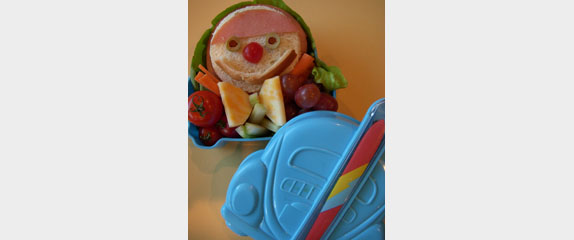Put a little life in a child’s lunchbox
I have been bonkers for obento for more than 25 years. On one of our year-long stays in Japan my son Brad, went to fa local elementary school. Like any mom, I prepared lunch for him–American style. I soon learned that wasn’t going to cut the mustard — or wasabi as it were. So I learned how to make Japanese-style lunch for him, obento. This daily exercise, changed my life and understanding of Japanese food forever. It made such a strong impression on me (and Brad), that it was the first article I ever wrote for the Boston Globe over 10 years ago. I also devote a chapter to obento in my new cookbook, My Japanese Table. Now obento is the latest Japanese culinary export. Here is the article.
By Debra Samuels
GLOBE CORRESPONDENT
DECEMBER 28, 2000 LIFE AT HOME SECTION
Is your child tired of the same old lunchbox fare? Have you had it with one more request for a Fluff sandwich? Are you suspicious that your children might be trading their carrot sticks for corn chips? Are you sure they couldn’t care less about any effort on your part?
We lived in Japan when my elder son was a first-grader. It was an education for all of us, not least of all when it came to the preparation and presentation of lunch for a 7-year-old. The Japanese moms made Rembrandts out of rice balls and fruit. Their masterpieces were not only nutritionally balanced, but also made your eyes water: mini. franks cut into the shape of an octopus, hard-boiled eggs cut to look like tulips. With a snip and a slice, the apple wedge became a bunny rabbit. W ith a tuck and a roll, a colorful spiral sandwich emerged. All the food groups were covered. Every child brought a folded cloth napkin and perky pals on the thermos in a handmade drawstring bag.
Needless to say, this did not go unnoticed by my son. It was great being the only American in class, but coming to school with peanut butter and jelly, celery sticks, banana, and juice box in a brown paper bag was demoralizing. To save his face and mine, I bought “100 Ideas on Children’s Obento” (portable lunches), just one of dozens of books and over sized how-to magazines in my local bookstore. Dazzling lunches are serious business for Japanese children and for their mothers, who would no more dream of creating an unplanned meal than their children would consider not eating every last morsel.
My son barreled through that book and chose the first of many edible art projects I would make that year: a sandwich in the shape of a little boy’s face complete with bologna bangs. Endless minifranks and fruit and vegetable ménageries later, I realized children did notice and did care. And yes, he did eat the whole thing.
Of course, I don’t recommend going to these lengths, nor do I subscribe to the concepts of guilt and obligation that underlie this.
(Well, maybe I do, but just a little.)
In Japan, however, there is a down side to all this: competition among the children and among the mothers. Moms are not just feeding their children or impressing them and their pals with their efforts. The teacher and other parents doing their PTA duties notice, too. Tongues cluck, children talk, and the teacher might even make a call home about a child’s being embarrassed and teased due to a mother’s insufficient effort.
Since 60 percent of Japanese women work I thought perhaps it was only the stay-at-home moms who had the time to do this. Wrong again. For everyone, working or not, there is internal and external pressure across educational and economic lines to make attractive, well-balanced meals with at least the appearance of their being homemade. Sure, plenty of women buy little salads, but before they go into the lunch box they are placed in a foil cup, and those store-bought meatballs are speared with a colorful plastic pick with a flag on top.
Even for someone like me, who loves playing with food and torturing little hot dogs into another species, this is way over the top. I did learn a great deal about the value of planning lunches and making them look appetizing, though. Children were delighted with their meals and ate with gusto.
With just a bit of effort and a few new ideas, you may be pleasantly surprised to find those lunch boxes comming back empty because the contents actually have been eaten, not fed to the trash.
(P.S. My sons never traded their meals when we came back to the States – they sold them!)
Apple Bunny
Cut and core one apple into 6 wedges. Slip a paring knife under the apple peel and slice carefully about two thirds of the way up. Cut a V into the apple skin flap and remove. You now have two ears. Add a splash of lemon juice to a small bowl of water and dip in the apple bunny to help prevent browning.
Octopus Franks
Cut each little frank almost to the top. You now have two pieces attached to the head.
Carefully slice each flap into thirds. Place in boiling water until the legs begin to curl up.
So this marine mollusk has six legs? Who’s counting?
Little Known Lunch Fact:
Boston Mayor Thomas M. Menino remembers this about his early school lunches: “In first grade, every day, I took bologna, except Friday, when I took tuna fish.”
Pinwheel Sandwich (Makes 4 servings)
4 slices of smoked salmon, turkey or ham
Bean sprouts, red or green pepper strips
4 slices of cheddar cheese or cucumber strips
12 slices of white or whole wheat bread, crusts removed
½ stick butter or margarine softened
¼ c. light mayonnaise(with 1 teaspoon mustard and or tarragon)
4 leaves of loose-leaf lettuce plastic wrap, washed and dried
Place 3 slices of bread in a row leading away from you on top of a sheet of plastic wrap.
Flatten the bread with a rolling pin. Spread with butter or mayo mixture and overlap the slices ¼ inch on the tops and bottoms. Press them together.
Place the lettuce on the two slices of bread closest to you. Place slices of salmon, turkey, or ham on top of the second slice of bread and the cheese on the third slice.
Add the sprouts (or other vegetables) on the salmon.
Lift up the first slice of bread and roll the sandwich forward, away from you.
Enclose the roll in the plastic wrap and chill overnight or for at least 2 hours. Slice into 4 rounds.
Repeat with remaining ingredients.
Make this the night before and slice in the morning.
Also try roast beef with spiced cream cheese, but avoid tuna and egg salads, as the bread will become soggy.
This story ran in the Boston Globe on 12/28/2001.
© Copyright 2001 Globe Newspaper Company.











 Debra Samuels, bestselling author, food writer and cooking instructor,
Debra Samuels, bestselling author, food writer and cooking instructor, 


